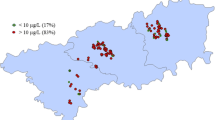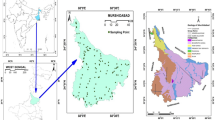Abstract
Arsenic (As) contamination in different areas of the world has been reported, which poses serious health threats to humans by its different routes of exposure. There exists comparatively rare data regarding arsenic level in groundwater of Punjab, Pakistan, which is normally used for drinking purpose. Therefore, the present study was planned to assess the contamination of arsenic in the drinking water of district Vehari in Punjab, Pakistan. A total of 156 drinking water samples were taken from different previously unexplored (rural and urban) areas. Various groundwater sources (electric pump, hand pump, and tube well) were targeted at different depths (50–350 ft) of the three tehsils (Burewala, Vehari, Mailsi) of district Vehari. Drinking water samples were subjected to measurement of the arsenic level, as well as other parameters of water were also checked including pH, electrical conductivity, chloride, cations, carbonates, and bicarbonates. It was found that 95% of groundwater samples were unfit for drinking purpose, because some areas of district Vehari were found with arsenic levels higher than World Health Organization (WHO) safe limit of As (10 μg/L) in drinking water. Arsenic-induced health risks were also estimated with respect to average daily dose, hazard quotient, and carcinogenic risk for the people who were relying on arsenic-rich groundwater for drinking purpose. It is found that the people of district Vehari are at the serious carcinogenic health risk. This study highlights that urgent management and monitoring measures are imperative for the people in the study area, in order to minimize the arsenic-mediated health effects, as well as to develop effective remediation strategies for arsenic-contaminated drinking water.



Similar content being viewed by others
References
Abbas M, Cheema K (2015) Arsenic levels in drinking water and associated health risk in District Sheikhupura, Pakistan. J Anim Plant Sci 25:719–724
Ahmad N, Ahmad M, Rafiq M, Iqbal N, Ali M, Sajjad MI (2002) Hydrological modeling of the Lahore-Aquifer, using isotopic, chemical and numerical techniques. Sci Vis 7:169–194
Alam MO, Shaikh WA, Chakraborty S, Avishek K, Bhattacharya T (2016) Groundwater arsenic contamination and potential health risk assessment of Gangetic Plains of Jharkhand, India. Expo Health 8:125–142
Ali M, Tarafdar S (2003) Arsenic in drinking water and in scalp hair by EDXRF: a major recent health hazard in Bangladesh. J Radioanal Nucl Chem 256:297–305
Azizullah A, Khattak MNK, Richter P, Häder D-P (2011) Water pollution in Pakistan and its impact on public health—a review. Environ Int 37:479–497
Bissen M, Frimmel FH (2003) Arsenic—a review. Part I: occurrence, toxicity, speciation, mobility. Acta Hydrochim Hydrobiol 31:9–18
Brammer H, Ravenscroft P (2009) Arsenic in groundwater: a threat to sustainable agriculture in South and South-east Asia. Environ Int 35:647–654
Caylak E (2012) Health risk assessment for arsenic in water sources of Cankiri Province of Turkey. CLEAN–Soil Air Water 40:728–734
Chakraborti D, Rahman MM, Das B, Murrill M, Dey S, Mukherjee SC, Dhar RK, Biswas BK, Chowdhury UK, Roy S (2010) Status of groundwater arsenic contamination in Bangladesh: a 14-year study report. Water Res 44:5789–5802
Chaudhary S (2005) Ground water quality in Faridabad, an industrial town of Haryana. J Ecotoxicol Environ Monit 15:263–271
Estefan G, Sommer R, Ryan J (2013) Methods of soil, plant, and water analysis: A manual for the west, Asia and North Africa region. ICARDA, Beirut
Farooqi A, Masuda H, Kusakabe M, Naseem M, Firdous N (2007) Distribution of highly arsenic and fluoride contaminated groundwater from east Punjab, Pakistan, and the controlling role of anthropogenic pollutants in the natural hydrological cycle. Geochem J 41:213–234
Fatmi Z, Azam I, Ahmed F, Kazi A, Gill AB, Kadir MM, Ahmed M, Ara N, Janjua NZ, Pakistan CGfAMi (2009) Health burden of skin lesions at low arsenic exposure through groundwater in Pakistan. Is river the source? Environ Res 109:575–581
Gunduz O, Bakar C, Simsek C, Baba A, Elci A, Gurleyuk H, Mutlu M, Cakir A (2017) The health risk associated with chronic diseases in villages with high arsenic levels in drinking water supplies. Expos Health. doi:10.1007/s12403-016-0238-2
Hoover J, Gonzales M, Shuey C, Barney Y, Lewis J (2017) Elevated arsenic and uranium concentrations in unregulated water sources on the Navajo Nation, USA. Expo Health 9:113–124
Iqbal H, Ishfaq M, Jabbar A, Abbas MN, Rehaman A, Ahmad S, Zakir M, Gul S, Shagufta BI (2014) Physico-chemical analysis of drinking water in district Kohat, Khyber Pakhtunkhwa, Pakistan. Int J Basic Med Sci Pharm (IJBMSP) 3(2):37–41
Jha A, Verma P (2000) Physico-chemical properties of drinking water in town area of Godda district under Santal Pargana (Bihar), India. Pollut Res 19:245–247
Jiang JP, Yuan XB, Ye LL, Liao SC, Zhang XH (2013) Characteristics of straw biochar and its influence on the forms of arsenic in heavy metal polluted soil. Appl Mech Mater 409:133–138
Karim MM (2000) Arsenic in groundwater and health problems in Bangladesh. Water Res 34:304–310
Kazi T, Arain M, Jamali M, Jalbani N, Afridi H, Sarfraz R, Baig J, Shah AQ (2009) Assessment of water quality of polluted lake using multivariate statistical techniques: a case study. Ecotoxicol Environ Saf 72:301–309
Khalid S, Shahid M, Dumat C, Niazi NK, Bibi I, Gul Bakhat HFS, Abbas G, Murtaza B, Javeed HMR (2017a) Influence of groundwater and wastewater irrigation on lead accumulation in soil and vegetables: Implications for health risk assessment and phytoremediation. Int J Phytoremediation. doi:10.1080/15226514.2017.1319330
Khalid S, Shahid M, Niazi NK, Rafiq M, Bakhat HF, Imran M, Abbas T, Bibi I, Dumat C (2017b) Arsenic behaviour in soil-plant system: biogeochemical reactions and chemical speciation influences. Enhanc Cleanup Environ Pollut. doi:10.1007/978-3-319-55423-5_4
Khan MU, Malik RN, Muhammad S (2013) Human health risk from Heavy metal via food crops consumption with wastewater irrigation practices in Pakistan. Chemosphere 93:2230–2238
Li P, Wu J, Qian H, Lyu X, Liu H (2014) Origin and assessment of groundwater pollution and associated health risk: a case study in an industrial park, northwest China. Environ Geochem Health 36:693–712
Li P, Li X, Meng X, Li M, Zhang Y (2016) Appraising groundwater quality and health risks from contamination in a semiarid region of northwest China. Expos Health 8:361–379
Malik AH, Khan ZM, Mahmood Q, Nasreen S, Bhatti ZA (2009) Perspectives of low cost arsenic remediation of drinking water in Pakistan and other countries. J Hazard Mater 168:1–12
Mehmood T, Bibi I, Shahid M, Niazi NK, Murtaza B, Wang H, Ok YS, Sarkar B, Javed MT, Murtaza G (2017) Effect of compost addition on arsenic uptake, morphological and physiological attributes of maize plants grown in contrasting soils. J Geochem Explor 178:83–91
Mohan D, Pittman CU (2007) Arsenic removal from water/wastewater using adsorbents—a critical review. J Hazard Mater 142:1–53
Mombo S, Foucault Y, Deola F, Gaillard I, Goix S, Shahid M, Schreck E, Pierart A, Dumat C (2016) Management of human health risk in the context of kitchen gardens polluted by lead and cadmium near a lead recycling company. J Soils Sedim 16:1214–1224
Mondal P, Bhowmick S, Chatterjee D, Figoli A, Van der Bruggen B (2013) Remediation of inorganic arsenic in groundwater for safe water supply: a critical assessment of technological solutions. Chemosphere 92:157–170
Muhammad S, Shah MT, Khan S (2010) Arsenic health risk assessment in drinking water and source apportionment using multivariate statistical techniques in Kohistan region, northern Pakistan. Food Chem Toxicol 48:2855–2864
Naeem A, Westerhoff P, Mustafa S (2007) Vanadium removal by metal (hydr) oxide adsorbents. Water Res 41:1596–1602
Nguyen VA, Bang S, Viet PH, Kim K-W (2009) Contamination of groundwater and risk assessment for arsenic exposure in Ha Nam province, Vietnam. Environ Int 35:466–472
Niazi NK, Burton ED (2016) Arsenic sorption to nanoparticulate mackinawite (FeS): an examination of phosphate competition. Environ Pollut 218:111–117
Niazi NK, Bishop TF, Singh B (2011) Evaluation of spatial variability of soil arsenic adjacent to a disused cattle-dip site, using model-based geostatistics. Environ Sci Technol 45:10463–10470
Niazi NK, Bibi I, Fatimah A, Shahid M, Javed MT, Wang H, Ok YS, Bashir S, Murtaza B, Saqib ZA (2017a) Phosphate-assisted phytoremediation of arsenic by Brassica napus and Brassica juncea: morphological and physiological response. Int J Phytorem 19:670–678
Niazi NK, Bibi I, Shahid M, Ok YS, Burton ED, Wang H, Shaheen SM, Rinklebe J, Lüttge A (2017b) Arsenic removal by perilla leaf biochar in aqueous solutions and groundwater: An integrated spectroscopic and microscopic examination. Environ Pollut. doi:10.1016/j.envpol.2017.09.051
Nickson R, McArthur J, Shrestha B, Kyaw-Myint T, Lowry D (2005) Arsenic and other drinking water quality issues, Muzaffargarh District, Pakistan. Appl Geochem 20:55–68
PCRWR (2016) Annual report 2014-15. Pakistan Council of Research in Water Resources, Khayaban-e-Johar, H-8/1, Islamabad-Pakistan: 1–93
Rafiq M, Shahid M, Abbas G, Shamshad S, Khalid S, Niazi NK, Dumat C (2017a) Comparative effect of calcium and EDTA on arsenic uptake and physiological attributes of Pisum sativum. Int J Phytorem 19:662–669
Rafiq M, Shahid M, Shamshad S, Khalid S, Niazi NK, Abbas G, Saeed MF, Ali M, Murtaza B (2017b) A comparative study to evaluate efficiency of EDTA and calcium in alleviating arsenic toxicity to germinating and young Vicia faba L. seedlings. J Soils Sedim. doi:10.1007/s11368-017-1693-5
Ravenscroft P, McArthur J, Hoque B (2001) Geochemical and palaeohydrological controls on pollution of groundwater by arsenic. Arsen Expos Health Effects IV:53–77
Richards LA (1954) Diagnosis and improvement of saline and alkali soils. Soil Sci 78:1–154
Shahid N, Zia Z, Shahid M, Faiq Bakhat H, Anwar S, Mustafa Shah G, Rizwan Ashraf M (2015) Assessing drinking water quality in Punjab. Pakistan. Polish J Environ Stud 24(6):2597–2606
Shahid M, Rafiq M, Niazi NK, Dumat C, Shamshad S, Khalid S, Bibi I (2017) Arsenic accumulation and physiological attributes of spinach in the presence of amendments: an implication to reduce health risk. Environ Sci Pollut Res Int. doi:10.1007/s11356-017-9230-z
Shakoor MB, Niazi NK, Bibi I, Rahman MM, Naidu R, Dong Z, Shahid M, Arshad M (2015) Unraveling health risk and speciation of arsenic from groundwater in rural areas of Punjab, Pakistan. Int J Environ Res Public Health 12:12371–12390
Shakoor MB, Niazi NK, Bibi I, Murtaza G, Kunhikrishnan A, Seshadri B, Shahid M, Ali S, Bolan NS, Ok YS (2016) Remediation of arsenic-contaminated water using agricultural wastes as biosorbents. Crit Rev Environ Sci Technol 46:467–499
Shrestha RR, Shrestha MP, Upadhyay NP, Pradhan R, Khadka R, Maskey A, Maharjan M, Tuladhar S, Dahal BM, Shrestha K (2003) Groundwater arsenic contamination, its health impact and mitigation program in Nepal. J Environ Sci Health Part A 38:185–200
Sultana J, Farooqi A, Ali U (2014) Arsenic concentration variability, health risk assessment, and source identification using multivariate analysis in selected villages of public water system, Lahore, Pakistan. Environ Monit Assess 186:1241–1251
US-EPA (2005) Guidelines for Carcinogen Risk Assessment; EPA/630/P-03/001F; Risk Assessment Forum: Washington, DC, USA
WHO (2011) Guidelines for drinking water quality. World Health Organization, Geneva
Wu J, Sun Z (2016) Evaluation of shallow groundwater contamination and associated human health risk in an alluvial plain impacted by agricultural and industrial activities, mid-west China. Expos Health 8:311–329
**ong T, Dumat C, Pierart A, Shahid M, Kang Y, Li N, Bertoni G, Laplanche C (2016) Measurement of metal bioaccessibility in vegetables to improve human exposure assessments: field study of soil–plant–atmosphere transfers in urban areas, South China. Environ Geochem Health 38:1283–1301
Zeng Y, Zhou Y, Zhou J, Jia R, Wu J (2017) Distribution and enrichment factors of high-arsenic groundwater in Inland Arid area of PR China: a case study of the Shihezi area, **njiang. Expos Health. doi:10.1007/s12403-016-0241-7
Acknowledgements
We are thankful to the Ministère des Affaires Etrangères et du Développement International (MAEDI), France for funding the Project (36099TC) under Bio-Asie 2016 program. We are also thankful to COMSATS Institute of Information Technology for research Project (16-81/CRGP/CIIT/VEH/13/198) under CRGP program under which the current research work was carried out.
Author information
Authors and Affiliations
Corresponding author
Rights and permissions
About this article
Cite this article
Shahid, M., Khalid, M., Dumat, C. et al. Arsenic Level and Risk Assessment of Groundwater in Vehari, Punjab Province, Pakistan. Expo Health 10, 229–239 (2018). https://doi.org/10.1007/s12403-017-0257-7
Received:
Revised:
Accepted:
Published:
Issue Date:
DOI: https://doi.org/10.1007/s12403-017-0257-7




